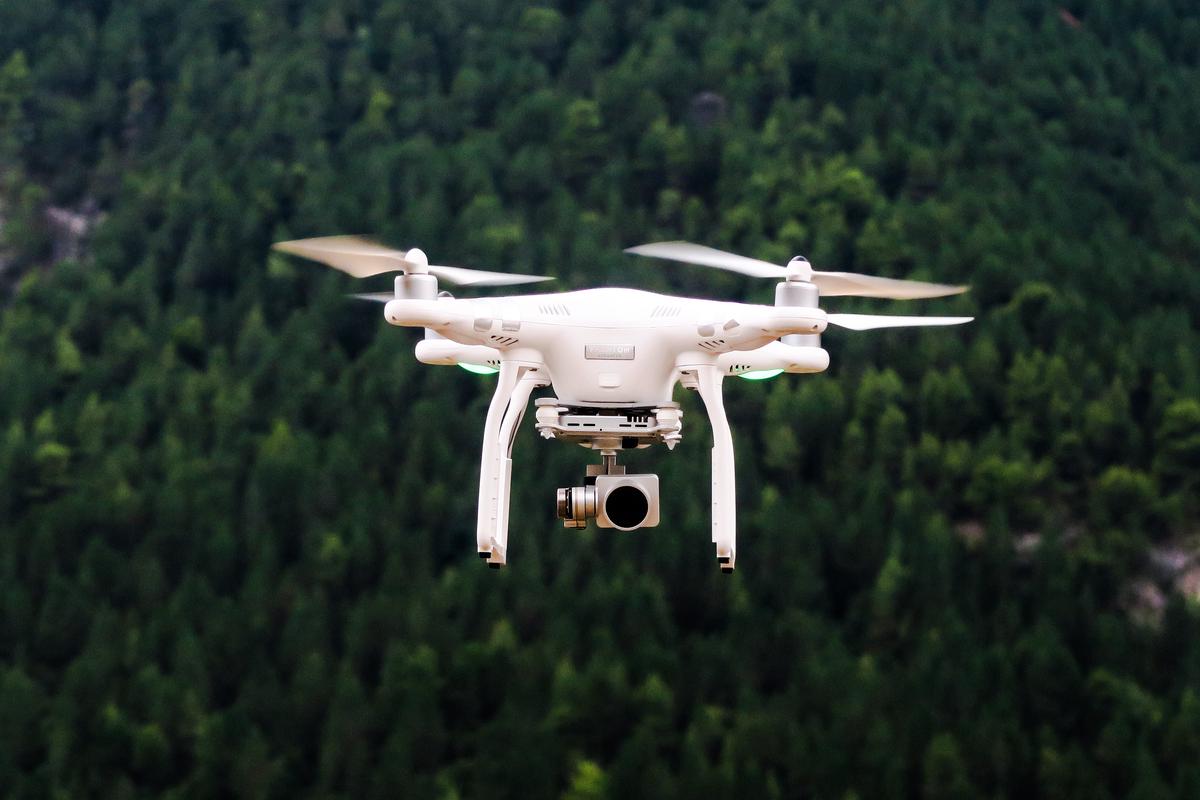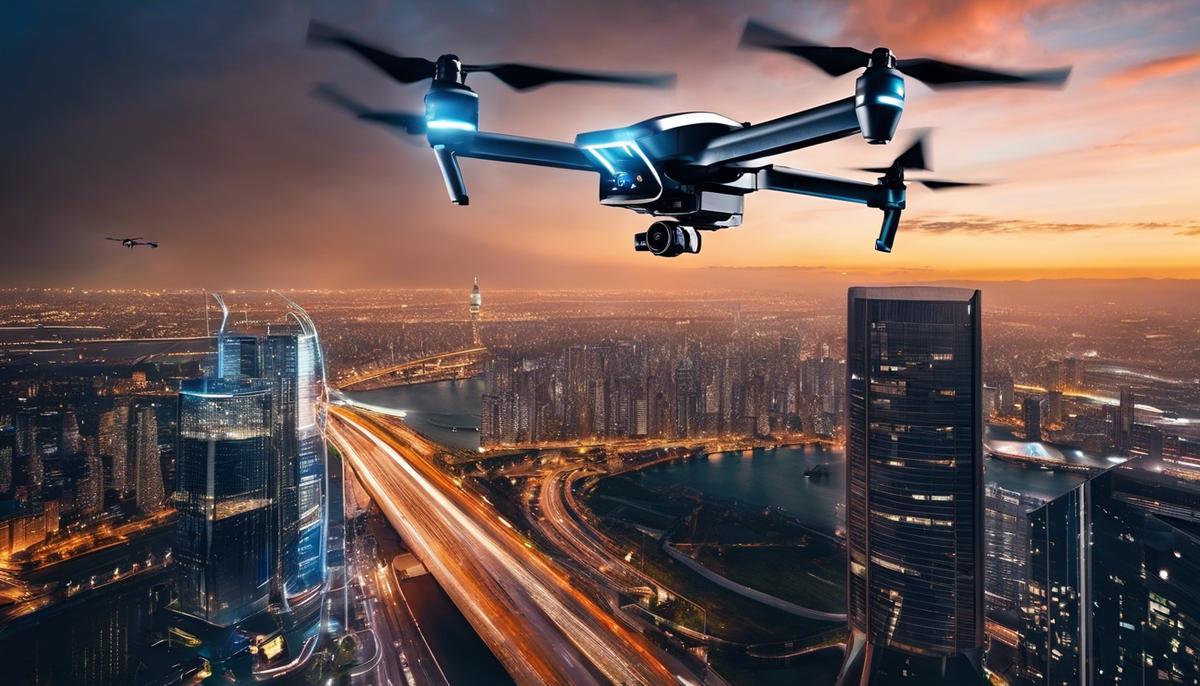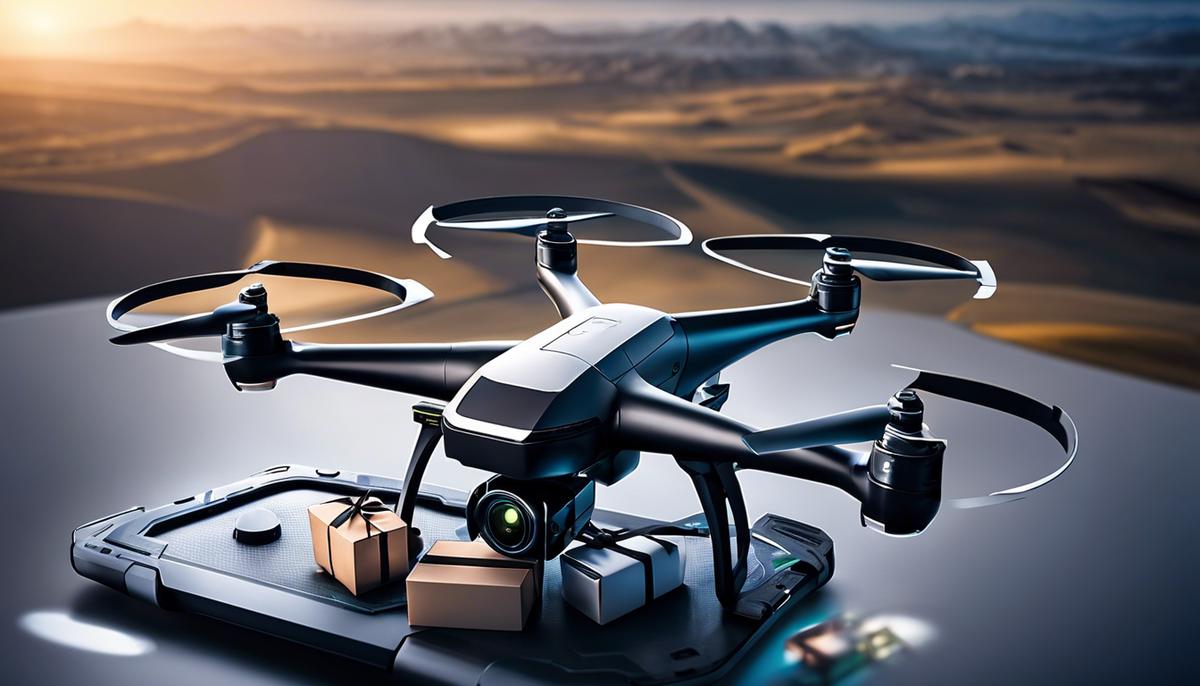Drone deliveries have become a common feature of modern commerce. With advancements in drone technology, the digital systems controlling them have become more complex, making cybersecurity measures crucial for safe and secure operations. In this article, we will explore the significance of cybersecurity in safeguarding drone delivery against a variety of cyber threats. These threats can include hacking, data breaches, spoofing, and GPS jamming, all of which have the potential to disrupt operations and compromise the systems. We will also discuss the best cybersecurity practices that drone delivery services can employ to stay secure and resilient. Additionally, we will conduct a comprehensive examination of the current legal and regulatory landscape surrounding drone cybersecurity. Looking to the future, we will explore how emerging technologies like artificial intelligence, machine learning, predictive analytics, and blockchain can redefine cybersecurity in the drone delivery industry.
The Importance of Cybersecurity in Drone Delivery Services
The Crucial Role of Cybersecurity in the Era of Drone Delivery Services
It’s remarkable how drones have skyrocketed from being merely an exciting novelty to crucial tools in the rapidly evolving e-commerce landscape. They’re undeniably a game-changer, dramatically redefining the concept of delivery efficiency and drastically shortening delivery times. However, as these Internet of Things (IoT) devices take command of the skies, the need for robust cybersecurity becomes increasingly pivotal. Why is that? Let’s unravel the details.
At the heart of drone delivery services lies the concept of seamless operations, which hinges heavily on secure digital functionalities. Without ironclad cybersecurity measures in place, the whole mechanism can derail rapidly, leading to operational interruptions, data breaches, or worse, potential disasters.
The primary reason anchoring the importance of cybersecurity in drone operations is data protection. Drone systems hold immense data, not just about the packages being delivered but also about the customers. Encrypted customer information, including names, addresses, and payment details, could become a gold mine for hackers if not securely stored and transmitted.
Without robust cybersecurity measures, cybercriminals can exploit vulnerabilities in the drones’ software and firmware. Once breached, this vulnerability can result in the hijacking of drones, leading to a compromise in the delivery process, deviation from programmed routes, theft of valuable packages, or potentially destructive crashes.
Furthermore, drones are increasingly leveraging AI algorithms for autonomous navigation. As impressive as this technology is, it also presents a new vector for cyber-attacks. Weak cybersecurity could let hackers modify or tamper with the AI algorithms, undermining the drone’s navigation ability and overall functionality.
Moreover, the communication links between drones and ground control stations are yet another essential area where cybersecurity comes into play. An unprotected communication link is an open invitation to hackers, making it a target for jamming or spoofing attacks, wherein the hackers interfere or forge the communication and control signals.
In an era where potential cyber threats are increasingly sophisticated, integrating advanced cybersecurity measures into drone technology isn’t just an option; it’s an absolute necessity. Blockchain technology, encryption, secure cloud data storage, intrusion detection systems, and regular security audits are some of the key solutions that can help mitigate the cybersecurity risks associated with drone delivery services.
Secure software development is another crucial area to invest in. Following secure coding practices minimizes software vulnerabilities, thereby reducing the avenues for cyberattacks. Also, continued training on security best practices for all personnel involved in drone operations can significantly raise the cybersecurity bar.
In conclusion, cybersecurity is the crucial cog in the seamless operation of drone delivery services. Without it, the futuristic vision of drone delivery doesn’t just falter; it might become a playground for cybercriminals. Thus, it’s an urgent call to technology companies, cybersecurity experts, and governmental bodies to form a unified front, prioritizing cybersecurity while reveling in the marvel of drone technology.
Unveiling the Major Cyber Threats Faced by Drone Delivery Services
In the rapidly evolving world of technology, drones are becoming an integral part of the e-commerce industry. Their deployment in the delivery of goods ushers in a new era of dynamism, heralding efficiency in logistics like never before. However, with great power comes great responsibility, particularly concerning cybersecurity. This article delves deeper into the diverse range of cyber threats that are knocking on the doors of drone delivery services.
The upward trajectory of drone usage directly correlates with an increased risk of cyberattacks. Identity theft stands tall among these risks. Cybercriminals strive to collect individual personal and financial information relayed during the delivery process. This transmission of seemingly harmless data regarding the customer’s residential address and payment options can serve a gold mine for malicious intentions if left unprotected.
Yet another looming threat is software and firmware exploitation. The advanced world of hackers has demonstrated alarming prowess in manipulating drone software, thereby gaining unwarranted control over the machines. Firmware, commonly overlooked, also houses a pool of vulnerabilities that if exploited, could wreak havoc on operations.
The technological marvel behind drone delivery services is the autonomous navigation systems powered by artificial intelligence. While these AI algorithms enhance and speed up delivery operations, they can also become victims of cyberattacks. The potential manipulation of these navigational systems by hackers poses a risk of delivery disruptions, theft, or even drone hijackings.
Adding fuel to the fire are the vulnerable communication links between drones and ground control stations. Interception of these signals could render the drones exposed to hijacks or falsified instructions, leading to delivery chaos. This exposes another unshielded flank in the broader battle against cyber threats in drone delivery services.
Considering the myriad of cyber threats, rectifying measures are being explored. The application of blockchain technology shows promise, ensuring transparency in transactions while also enhancing security. Encryption serves its traditional role of warding off unauthorized access, while secure cloud storage provides an additional cloak of security for data transactions. The implementation of intrusion detection systems and periodic security audits further tightens the grip on cybersecurity.
Additionally, software development underpinned by secure coding principles is of paramount importance. The adherence to stringent coding standards tends to eradicate most software vulnerabilities at the nascent stage, offering a more robust defense mechanism.
No real solution would be complete without the involvement of humans behind the scenes – the operators. Constant training on best practices in the field of cybersecurity for all relevant personnel heavily contributes to the prevention of incipient threats.
Undoubtedly, cybersecurity in drone delivery services is an urgent necessity. It necessitates collaboration between technology companies, cybersecurity specialists, and governmental bodies to ensure that the sky remains a safe haven for drone operations.

Best Practices in Cybersecurity for Drone Delivery
Biometric Authentication: Bio-Secure Drones
A cutting-edge tactic often overshadowed in the media but nevertheless essential in mitigating cybersecurity threats in drone delivery services is the employment of biometric authentication. Utilizing distinct human characteristics such as facial recognition or fingerprint scanning, biometric authentication ensures that only authorized individuals can access and control these high-tech gadgets, effectively minimizing the risk of unauthorized tampering or theft.
Real-time Threat Recognition: Automatic, Analytical, Aware
Pertinent to drones are real-time threat recognition systems. Just as an e-commerce site uses predictive algorithms to suggest the next great gadget, a drone should utilize similar real-time analytical software to spot potential threats. Integrating machine learning can enhance these systems to recognize and learn the changing tactics of cybercriminals, ensuring that drones remain one step ahead.
The Geofencing Solution: Invisible Boundaries, Visible Efficiency
Geofencing can be a potent tool in the cybersecurity arsenal for drone services. Having a virtual geographical boundary set up through GPS or RFID technology allows for precise control over where drones can and cannot venture. Given their reliance on location and movement, this technology can autonomously restrict drones from entering high-risk, unsecured areas or even cybercriminal hotspots.
Redundancy: The Double-Check Maneuver
Redundancy systems are an effective cybersecurity measure that ensures crucial control systems within the drone remain operational even if certain aspects are compromised. Duplicate components add an extra layer of resilience and reduce instances of system failure. Should a cyber threat attempt to infiltrate, the redundancy can immediately take over, ensuring the drone’s operation while simultaneously isolating the affected components for subsequent recovery.
Incident Response Plans: Expect the Unexpected
Despite all measures, the risk of breaches always lingers. It is critical that companies utilizing drone technology have an articulate and forthright incident response plan. A well-devised plan can help mitigate damage, reduce recovery time, and ensure the breach’s learnings are incorporated into bolstering cybersecurity moving forward.
Public Key Infrastructure (PKI): Trusted Communication Bridge
PKI plays an essential role in the safe piloting of drones. Public and private cryptographic key pairs, combined with a trusted certificate authority, can help ensure secure, authenticated, and encrypted communications between drones and command centers. This secure communication bridge can considerably reduce man-in-the-middle attacks.
The future is unmanned, and it is happening now. With the swift pace of advancements in drone technology, the importance of cybersecurity cannot be overstated. As we race towards a future sky-lit with drones, ensuring these machines’ resilience and safety to cyber threats is a crucial and immediate consideration.
Legal and Regulatory Considerations in Drone Cybersecurity
Navigating the Complexity of Legal and Regulatory Frameworks on Drone Delivery Cybersecurity
Drone technology has truly taken flight over the last decade. To keep pace, a myriad of legal and regulatory frameworks have been erected to shape and guide operations and, more importantly, drone delivery cybersecurity.
At the heart of these frameworks are issues like privacy and data protection, airspace regulation, and, unsurprisingly, cybersecurity. As we continue to chart this modern airspace, understanding these legalities and regulations is paramount to enabling safe and secure drone operations.
Worldwide, aviation agencies like the United States Federal Aviation Administration (FAA), the European Union Aviation Safety Agency (EASA), and the Civil Aviation Authority (CAA) in the UK enforce regulations on drone usage. They focus on safety, privacy, and data handling. Specific laws apply to both consumer and commercial drones, outlining operations, licensure, data collection, and sharing.
In terms of cybersecurity, there is a broad brush of regulatory issues at play. Firstly, drones must adhere to cybersecurity standards, such as ISO 27001. This international standard outlines best practices for an information security management system (ISMS), encapsulating processes that protect user data.
Under regulations like GDPR in the EU and CCPA in the U.S., data privacy is mandatory for any drone system transmitting personal data. Cybersecurity measures must demonstrate robust protection against identity theft and unauthorized data sharing.
Moreover, as drone technology leans heavily on artificial intelligence, adherence to AI regulation is de rigueur. Several nations and regulatory bodies have AI policies related to transparency, accountability, and privacy, which directly impact AI-operated drone systems.
Finally, the laws governing communication over the internet, such as the Digital Millennium Copyright Act in the U.S., affect drone communications. Secure, encrypted links between drones and ground control are a requirement to prevent unlawful interception and unauthorized command and control.
But despite these regulatory frameworks and laws, gaps persist. The majority of safety-oriented drone legislation does not explicitly address cybersecurity or the potential for cyber-attacks. Ongoing dialogue among tech companies, cybersecurity experts, and government bodies can fuel more comprehensive development and application of regulations.
In conclusion, the future of drone delivery cybersecurity hinges on the effective transformation of today’s legal landscape. Cybersecurity and privacy regulations must evolve in tandem with emerging technologies, ensuring a robust shield against hackers in our increasingly connected skies.
The frameworks and regulations just reviewed signify a crucial leap forward in the race toward ensuring a secure, harmonious drone environment. But the challenge is far from over. Only through relentless vigilance, constant adaptation, and unprecedented collaboration will it be possible to fly confidently into the future.

The Future of Cybersecurity in Drone Delivery Services
Custom Hardware and Vulnerability Scoring
The race to dominate the drone market has given birth to a multi-faceted industry where manufacturers proudly tout tailor-made hardware solutions. While bespoke hardware can provide an edge in terms of performance, it arguably leads to a fragmented landscape in which cybersecurity measures need to be tailor-fit rather than universally applicable. Embracing standardized hardware can simplify cybersecurity implementation and facilitate easier vulnerability tracking and fixing, especially with a common vulnerability scoring system universally employed.
Devices with a Physical Unclonable Function (PUF)
Considered an emerging technology, devices equipped with a PUF help heighten security in drone systems. A PUF refers to a digital fingerprint unique to each chipset, enabling it to authenticate and validate individual drones. Guaranteeing a level of assurance in terms of identifying individual devices, the adoption helps curb unauthorized access and reduce the potential for breaches.
Digital Twinning
Drawing from the world of aerospace technology, digital twin technology can offer a proactive means for identifying potential hardware malfunctions and software vulnerabilities. Digital twinning generates a real-world, software-based model of a drone that can be tested and evaluated for various scenarios, acting as an early detection system for possible problems that can lead to cyber-attacks.
Cyber Hardening
Cyber Hardening is described as an essential step in developing robust drone delivery systems. Conventionally, applications are built first for functionality and then layered with security measures. Cyber hardening proposes a shift by incorporating security at each step of the development pipeline. This approach reduces the chance of residual vulnerabilities making their way into the final drone product.
Quantum Cryptography
As quantum computing evolves, so too does the potential for quantum hacking. However, the same technology represents a double-edged sword, offering a new horizon for cyber defenses: quantum cryptography. It provides a theoretically un-hackable method of encryption, thanks to the principles of quantum mechanics. This, however, is subject to the accessibility of quantum computers, which, at present, remains limited.
Collaborative Efforts and Open Source Technology
Given the shared issues in drone cybersecurity, it’s beneficial to encourage open-source developments and collaborative efforts. Publicly available source code permits robust analysis and collective problem-solving. By doing so, weaknesses can be spotted and fixed faster, transforming the development landscape into a communal cybersecurity endeavor.
In the end, it’s clear that the future of drone delivery cybersecurity isn’t hinged on a single solution or technology but on a collective shift in perspective. Cybersecurity shouldn’t be viewed as an incremental part of the development process but rather an integral aspect of every step. Combining industry collaboration, advanced technology adoption, and legislative measures can pave the way for a secure, reliable drone delivery sector.

As drone delivery services continue to revolutionize commerce and logistics, maintaining robust cybersecurity will only grow in importance. It’s clear that managing cyber threats requires a multifaceted approach, employing a mix of best practices from secure communication to regular software updates. Navigating the legal and regulatory landscape is also key to aligning practices with standards and laws effectively. But more than just following the recommended practices of today, companies need to keep an eye on the horizon. Emerging technologies like AI, predictive analytics, and blockchain hold great potential to enhance drone delivery’s cybersecurity further. Embracing these technologies will be essential for companies wishing to stay ahead in this dynamic, fast-evolving sector, securing both their operations and the future of the drone delivery industry.
